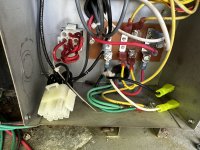Hi,
I have been reading as many old threads to try and understand why my heater kicked the bucket. I just found my multimeter and am going to dig around inside more based on the electrical flowchart.
While I am doing that I thought I would post my specific failure scenario to see if it can give a clue on what to hone in on.
Heater was working then disconnected for 2+ years during a messy reno.
Previous system was Easytouch, current system is Intellitouch.
Heater is connected 220v with the proper plug and the firemans switch currently jumpered.
On initial power up, heater came on and started working for a couple of minutes. Then the fuse blew.
After replacing the fuse, heater boots up normally ( r13 on display) then does nothing. No buttons elicit any response.
There are no lights on control board or on ignition control board.
Thanks in advance!!
-Kevin
I have been reading as many old threads to try and understand why my heater kicked the bucket. I just found my multimeter and am going to dig around inside more based on the electrical flowchart.
While I am doing that I thought I would post my specific failure scenario to see if it can give a clue on what to hone in on.
Heater was working then disconnected for 2+ years during a messy reno.
Previous system was Easytouch, current system is Intellitouch.
Heater is connected 220v with the proper plug and the firemans switch currently jumpered.
On initial power up, heater came on and started working for a couple of minutes. Then the fuse blew.
After replacing the fuse, heater boots up normally ( r13 on display) then does nothing. No buttons elicit any response.
There are no lights on control board or on ignition control board.
Thanks in advance!!
-Kevin








